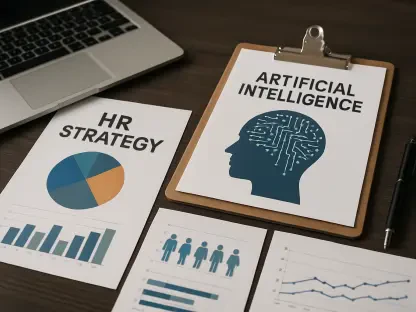In rapidly evolving organizational landscapes, Chief Human Resources Officers (CHROs) are emerging as key figures in aligning artificial intelligence (AI) with human-centric strategies. As generative AI transitions from an innovative concept to a critical business tool, HR leaders are increasingly significant in ensuring a harmonious integration of AI within organizational goals. Their role is pivotal in guiding AI adoption by fostering employee trust, enabling skill enhancements, and restructuring the workforce.
The Rapid Rise of Generative AI
Generative AI has experienced remarkable growth and development over the past couple of years, evolving from an intriguing novelty to a powerful catalyst in the business world. U.S. companies are projected to spend over $300 billion on AI investments. This significant financial commitment underscores the belief that AI will be transformative for various sectors. Furthermore, most organizations plan to escalate their AI budgets, showing a strong commitment to leveraging this technology for future success. Despite these substantial investments, firms often encounter challenges in achieving swift returns, highlighting the intricate nature of AI implementation and its varied pace in delivering tangible outcomes.
This surge in generative AI adoption reflects its potential to revolutionize various aspects of business operations. Deloitte’s research suggests that a considerable majority of organizations recognize this technology’s capacity to drive industry-wide transformations in the near future. The journey from initial investment to observable benefits is often protracted, indicating the complex interplay between technological advancements and organizational readiness. HR leaders are thus critical in navigating this landscape, ensuring that AI integration is both effective and aligned with broader business objectives. The challenge lies in balancing the ambitious goals tied to AI investments with the practical realities of implementation.
Potential Outcomes of AI Integration
The future of AI integration presents several potential outcomes, each with its unique set of advantages and challenges over the next few years. One possibility is significant growth, albeit accompanied by substantial costs. In this scenario, businesses that effectively leverage AI will benefit from enhanced productivity and freed-up resources, allowing employees to focus on more meaningful tasks. However, this rapid transformation may lead to decreased trust and autonomy among workers, posing a potential risk to employee satisfaction and engagement. Another potential outcome is the AI bubble bursting, where early adopters may face talent loss and diminished innovative capabilities if AI implementations fail to deliver expected results. This scenario could drive employees towards organizations adopting a more measured approach to AI integration.
Conversely, a human-directed strategic advancement is another possibility. Organizations led by cautious HR teams might initially experience slower progress in harnessing AI’s full transformative potential. However, this prudent approach allows for a more strategic and insightful growth trajectory, balancing potential disadvantages with incremental but steady progress. Lastly, some companies might dive headfirst into generative AI, aiming to outpace competitors and maximize productivity rapidly. While this approach carries the potential for substantial gains, it also risks outstripping market readiness, creating overly complex systems, and alienating staff due to role diminishment. Each of these scenarios highlights the strategic decisions companies must make to navigate AI integration effectively.
Human-Centric AI Adoption
At the heart of successful AI integration lies the human-centric approach championed by HR departments, particularly CHROs. By infusing AI initiatives with strategies that prioritize human elements, HR can ensure technology enhances workforce dynamics. This involves nurturing trust, facilitating continuous skill development, and redesigning job roles to support ongoing innovation. Human-centric AI adoption also means recognizing and addressing concerns employees may have about the impact of AI on their roles. Transparent communication about AI’s potential and limitations will help build trust, enabling smoother transitions and higher acceptance rates among staff. Moreover, fostering a culture of continuous learning ensures employees are equipped to work alongside AI, optimizing its benefits while mitigating disruption.
HR leaders play a crucial role in facilitating AI fluency among employees, tailoring training programs to varied skill levels and personalizing career paths. Identifying future-critical skills and creating pathways for smooth transitions into AI-augmented roles is essential for sustaining organizational growth. Redefining job roles is also crucial as AI reshapes work nature; HR must revise workforce planning models to accommodate new requirements and opportunities. Strategies to attract early-career talent and reskill mid- to late-career employees are vital to managing this transition effectively. Ultimately, infusing human-centric strategies into AI initiatives ensures that technology serves its broader purpose without compromising workforce integrity.
Strategic Business Alignment
Achieving strategic business alignment is pivotal for maximizing the value of AI investments. HR must work closely with business leaders to ensure AI initiatives are focused on resolving critical organizational challenges, enhancing productivity, and improving customer experiences. This collaborative approach helps in minimizing disruptions to employee workflows, ensuring AI serves its intended purpose and aligns with broader business objectives. By aligning AI initiatives with strategic business outcomes, companies can concentrate on leveraging technology to drive meaningful progress. The insight and understanding HR leaders bring to this process are instrumental in identifying areas where AI can add the most value without negatively impacting existing operations.
HR departments must implement robust frameworks that facilitate the smooth integration of AI into daily business practices. This requires clear communication and setting realistic expectations about AI’s capabilities and impact. Providing regular updates and feedback ensures employees remain informed and engaged throughout the transition. Trust and transparency are fundamental, as the successful implementation of AI initiatives hinges on the workforce’s acceptance and understanding of its role. Establishing accountability frameworks, wherein specific leaders are tasked with overseeing AI outcomes, can further reinforce confidence and consistency. This strategic alignment between AI initiatives and business goals ensures that technology is utilized effectively and sustainably.
Building Trust and Transparency
Building trust and maintaining transparency are key elements for successful AI adoption. As organizations embark on integrating AI, HR must lead efforts to communicate clearly about the impact of AI on roles and decision-making processes. Transparent communication plans are vital in addressing employee concerns and fostering a culture of trust. Research shows that trust significantly boosts AI adoption, making it imperative for HR to develop strategies that keep employees informed and confident about AI initiatives. One approach is to create accountability frameworks assigning specific leaders to oversee AI outcomes. These leaders can provide consistent updates, ensuring that employees are aware of progress and changes.
HR can also facilitate transparency by establishing clear channels for feedback and dialogue. Encouraging open discussions about AI’s implications, benefits, and limitations helps in building a collective understanding and acceptance. This involves not just informing but also actively engaging employees in the conversation about AI integration. Regular updates and transparency in decision-making processes will keep the workforce aligned with the organization’s AI strategy. Reassuring employees through well-defined plans and frameworks alleviates uncertainties, fostering a supportive environment for AI adoption. Ultimately, maintaining transparency and building trust are foundational aspects that enable successful AI integration and sustained workforce engagement.
Continuous Learning and Upskilling
Prioritizing continuous learning and upskilling is pivotal as organizations integrate AI into their operations. HR departments must design and implement training programs that build AI fluency, catering to varied skill levels across the workforce. Tailoring these programs to individual career paths helps employees transition smoothly into AI-augmented roles and ensures comprehensive skill development. Continuous learning initiatives are essential for sustaining organizational growth and innovation, equipping workers with the knowledge and expertise needed to leverage AI’s capabilities effectively. This approach also involves recognizing and addressing skill gaps, ensuring employees are prepared for emerging challenges and opportunities presented by AI.
Identifying future-critical skills is a vital component of this strategy. HR leaders must pinpoint skills that will be crucial in an AI-driven landscape and create pathways for employees to acquire and develop these abilities. Investing in continuous learning and upskilling fosters a culture of growth and adaptability, allowing organizations to remain competitive and innovative. By offering tailored training programs, HR can support employees in their professional development, enhancing overall productivity and job satisfaction. This forward-thinking approach to human capital management ensures that companies can navigate the complexities of AI integration while promoting a knowledgeable and agile workforce.
Redefining Workplace Roles
As AI continues to reshape work nature and job functions, HR must lead efforts to revise workplace planning models to accommodate these changes. Redefining roles entails examining current job descriptions and identifying new opportunities that align with AI capabilities. Attracting early-career talent is crucial to supporting a workforce skilled in AI technologies. Strategies to showcase growth opportunities and career advancement paths can draw in fresh talent eager to navigate the AI landscape. Additionally, reskilling mid- to late-career employees ensures that existing staff remain relevant and valuable to the organization as AI transforms various operational aspects.
HR departments should focus on developing frameworks that support these transitions, ensuring seamless integration of AI into day-to-day activities. By revising workforce planning models, HR can address evolving job requirements and organizational needs. This includes creating new roles that leverage AI while maintaining a balance between technological enhancement and human input. Effective reskilling programs that align with AI initiatives are vital for keeping the workforce adaptable and competitive. Through strategic workforce planning, HR can guide organizations through the challenges of AI integration, ensuring they harness technology’s benefits without undermining workforce stability. This proactive approach to redefining roles and workforce structures is key to fostering a dynamic and resilient organizational environment.
Fostering Creativity and Innovation
In today’s rapidly evolving organizational environments, Chief Human Resources Officers (CHROs) are becoming crucial to harmonizing artificial intelligence (AI) with human-centered strategies. As generative AI moves from being an innovative idea to becoming an essential business tool, HR leaders play an increasingly vital role in ensuring its seamless integration within organizational objectives.
HR leaders’ involvement is critical for guiding AI adoption, mainly by fostering employee trust in new technologies, enabling skill advancement, and reshaping workforce structures. Their responsibility extends to ensuring employees understand the benefits and implications of AI, cultivating a culture of adaptability and continuous learning, and reevaluating job roles and responsibilities to align with AI advancements.
In essence, CHROs must balance the technological potential of AI with the human elements that drive organizational success, creating an environment where AI and human skills complement each other. By doing so, they help their organizations navigate the complexities of AI implementation while prioritizing a people-first approach.









